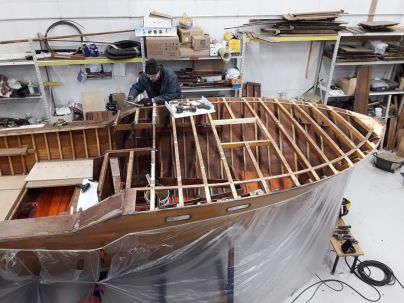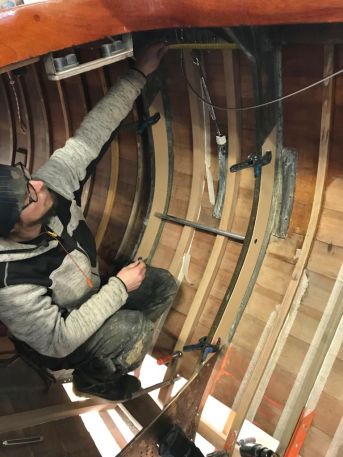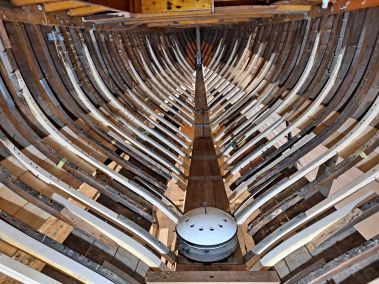Wooden boat repair
| Wooden boat repair | ||||
|---|---|---|---|---|
| In the national inventory | ||||
|

Practitioners and people who know the tradition well
Wooden boat hobby and owning a wooden boat are significant activities in Finland. Until the 1950s, nearly 100% of all small boats manufactured were made of wood, so there are still tens of thousands of wooden boats in Finland, some in use, some not, and some stored in boat sheds or warehouses due to damage, waiting either for restoration or disposal. A large portion of wooden boat owners repair their boats themselves, but professionals also assist in the work. Many different organisations promote the repair and maintenance of wooden boats. The Heritage Centre Kuggom (Perinnekeskus Kuggom) regularly organises wooden boat repair courses, and many other institutions, especially community colleges, occasionally offer wooden boat repair courses as well.
Currently, there are approximately 60 professional wooden boat builders in Finland. Most professionals are organised under the Wooden Boat Builders Association (Suomen puuveneveistäjät ry), whose membership consists of the finest boatyards in Finland and experienced boat builders with years of experience in crafting and repairing wooden boats. Established in 1990, the professional association aims to improve the conditions for practising the trade. The association actively works to enhance the appreciation of wooden boats and the development of the wooden boat hobby and industry.
The Finnish Wooden Boat Association (Suomen Puuveneilijät ry) has around 800 private members who collectively own over 1,000 wooden boats. The association annually organises boat care courses and courses related to minor boat repairs.
The Mahogany Yachting Society (or MYS) was established in 1992. The society's mission is to promote the preservation of classic boats, the construction of new boats, and support boat owners in their active hobby. Membership is open to individuals interested in classic motor- and sailboats, whether they own a boat or not. Mahogany Yachting Society started to administrate the Register of Classical boats in Finland. After several years work, the register was covering the great part of the classical and old sailing- and motorboats of Finland. Later the Finnish National Museum as a state owned organization took care of the register.
Additionally, there are numerous local wooden boat associations and yacht clubs along the coastline and major inland water bodies in Finland.
Practising of the tradition
In Finland, there are several boat clubs primarily maintained by wooden boat enthusiasts. These clubs provide a relatively good foundation for the maintenance, restoration, and overall upkeep of wooden boats.
Numerous wooden boat events, both small and large, are organised annually in Finland. There is a significant need for repairs because the average age of wooden boats is relatively high, which naturally leads to repair requirements. Wooden boats often require repairs due to sudden damages, such as running aground, or issues arising from inadequate or unsuitable winter storage. Various wooden boat events, as well as maintenance and repair courses organised by educational institutions and associations, contribute to the continuation of this tradition. Museums like the Finnish Maritime Museum in Kotka, Forum Marinum in Turku, and numerous archipelago and boat museums play a significant role in preserving the tradition, especially by documenting various traditional boat designs found in different regions and created by various designers and craftsmen.
Repairing and maintaining a wooden boat involves a wide range of techniques and procedures. It can be cosmetic, such as repairing varnish or paint surfaces, replacing the sealant of leaking seams, mending cracked boards, replacing entirely decayed or damaged wooden parts, patching, repairing or replacing broken frames, and more. In the worst cases, restoring a boat can entail disassembling it down to its individual components and reassembling it, making it almost like a new boat. In such extensive restoration projects, the process may span several years.
Today, the tools and equipment available for wooden boat repair are considerably more advanced than they were a hundred years ago. Repair professionals have access to modern adhesives, fillers, woodworking machinery, as well as power tools, including sanders and hand routers. The internet is also a valuable source of information, and peer support is readily available in various wooden boat-related groups and forums.
In Finland, various courses are currently offered, with longer courses aimed at, for example, building one's own boat or restoring an existing boat, while shorter weekend courses help participants learn essential skills and find answers on how to get a wooden boat stored in a winter storage space or garage ready for the water.
The protection of the wooden boat's hull from moisture is essential. The most popular method involves impregnating the wooden boat's hull with more than ten litres of preservative oil for a 5-6 metre long wooden boat. The goal is to fill the wood's cells with preservative oil, preventing it from absorbing water. Typically, impregnation is applied only to the boat's hull, not the deck or cabin structures. The impregnation needs to be renewed every 10-20 years because the oil gradually carried away, causing the wood to dry out, potentially leading to cracks if it's not sufficiently impregnated. After impregnation, the surface can be treated in various ways, such as varnishing, tarring, or painting. All these methods require annual maintenance. If maintenance is neglected or done incorrectly, or if a wooden boat is left exposed to the elements for too long, there is a significant risk of wood damage, necessitating extensive repairs and often requiring replacing the damaged section with new wood.
A wooden boat requires annual maintenance. For example, sunlight during summer can damage surfaces that have been varnished , which is why it's necessary to perform maintenance varnishing before the next season, including more thorough work where the varnish is damaged. The surface is lightly sanded, followed by the application of a new layer of varnish. Varnishing is a task that requires skill, and there are as many styles as there are craftsmen. Factors to consider include the coarseness of sanding, the type of varnish used, whether it should be thinned, the extent of thinning, the use of rollers, brushes, or both, and whether it's possible to create a dust-free environment. This is one
example of where the challenge and beauty of the wooden boat hobby lies. Everyone has the chance to do things in a proven way, but sometimes the abundance of advice and guidelines can make it difficult to decide how to proceed.
The background and history of the tradition
Boats have been built as long as there have been settlements by the water. Evidence can be found in 5,000-year-old Stone Age paintings. In Finland, a few Stone Age paddles and dugout canoes have been discovered, but the actual boat finds are less than a thousand years old. Boats were present in all family households that lived by the water.
For a very long time, up until around the 1950s, the only method of boat construction was using wood. Boats served various purposes, including fishing boats, cargo transport vessels, commuter boats, and church boats. Sail rigs were added to rowing boats over time, giving rise to a new category known as sailboats. In the early 1900s, combustion engines were introduced for longer journeys and heavier cargo transportation. In the last hundred years, recreational boating and competitive racing boats have also emerged.

The transmission of the tradition

Throughout Finland, dozens of wooden boat events are organised during the boating season. These events also focus on wooden boat repair through informational sessions, event briefings, and lectures. Often, there are wooden boat builders present who, as part of their demonstrations, provide information on wooden boat repair. Some of these events include:
● Small Ships Race (https://www.facebook.com/events/loviisan-laivasilta-lovisa-skeppsbron/small-ships-race/496497954941441/)
● Puuveneen vuoksi (http://digisaimaa.fi/2022/07/20/puuveneen-vuoksi/)
● Puupaatei Pakkahuoneel (https://visituusikaupunki.fi/fi/nakemista-ja-tekemista/puupaatei-pakkahuoneel-ja-molja-miittinki-1282023)
● Meriviapori (https://www.stadissa.fi/tapahtumat/19718/meriviapori)
● Viaporin Tuoppi (http://www.viaporintuoppi.fi/)
● Sulkavan soutu (https://www.suursoudut.fi)
The preservation of wooden boat repair traditions is primarily driven by individual wooden boat clubs and associations, as their members repair their own boats and, in doing so, guide others in proper repair techniques. Many of these clubs and associations also publish their own magazines, showcasing various repair methods. For example, the Finnish Wooden Boat Association (Suomen Puuveneilijät ry) publishes and delivers the Puupaatti magazine to all its members. Heritage Centre Kuggom (Perinnekeskus Kuggom) also organises both short and long wooden boat repair courses annually.
Safeguarding tradition
The wooden boat industry is threatened by a decrease in active users because new wooden boats are no longer ordered or purchased for regular everyday use, which was their original purpose. Currently, the average age of wooden boats in use is relatively high, as the majority of wooden boats were built in the 1950s to 1980s. The production of new
wooden boats has significantly dropped since the 1960s, as new construction methods using materials like plastic, fibreglass and aluminium have gained popularity.
The preservation of the wooden boat tradition largely relies on maritime museums and dedicated enthusiasts. The tradition and expertise in wooden boat repair have a somewhat stronger foundation due to regularly organised maintenance and repair courses, as well as the self-driven efforts of wooden boat enthusiasts.
How is tradition recorded?
The methods and traditions of wooden boat repair have been documented in numerous books, serving as guides both in various wooden boat building courses and especially as a source of knowledge for wooden boat enthusiasts repairing their own boats. Since there are several repair methods, there are also varying opinions on what are the correct and effective ones. Especially with the introduction of new adhesives, wood treatment, and surface finishing materials, opinions vary regarding the suitability of different repair methods. This raises questions like: Can a traditional wooden boat be repaired using methods other than traditional ones, since new and effective methods have already been proven to be suitable?
At Heritage Centre Kuggom (Perinnekeskus Kuggom), both short and long wooden boat repair courses are documented in written form, with photographs, and some of the work stages are also recorded on video. Previously, there hasn't been much material suitable for archiving of these repairs.
The future of the tradition
Wooden boat hobby, ownership, maintenance, and restoration are gradually decreasing as old and deteriorating boats are taken out of service, and this happens more often than the number of new wooden boats being manufactured. Approximately 40-50 new wooden boats are produced annually, and this isn't sufficient to replace the number of boats being retired from service. The core group of enthusiasts has remained relatively stable over the past few decades, but these enthusiasts are also ageing, and with age comes a reduced ability to perform the annual maintenance required for their boats. Valuable traditional wooden boats are left unused and unattended each summer. Some of them are also left outdoors without protection, and over the years, the boats suffer the effects of the weather. It's crucial to pass on these unused boats to the next generation so that the tradition of active annual maintenance and repair, along with the active hobby and the care that comes with it, can be preserved.
We are currently experiencing a societal transition. Ownership and maintenance of wooden boats are considered labour-intensive, especially for those with limited contact with wooden boats. At the same time, significant societal changes are happening, which should lead to a greater appreciation of wooden boats. For future generations, boat ownership and the carbon footprint associated with boat construction and use are becoming increasingly important. The construction of a wooden boat has an environmentally friendly aspect; building a new wooden boat from wood contributes positively to reducing the carbon footprint. Wood naturally absorbs carbon, and as long as the boat remains in active use and well-maintained, its carbon content remains stable. In comparison, boats made from other materials have a much larger carbon footprint than wood. By choosing a wooden boat as your vessel, you are making a significant environmental impact. Demonstrating that the maintenance and repair of wooden boats do
not have to be as difficult and labour-intensive as commonly perceived can help revive the wooden boat tradition and promote an understanding of old, valuable principles.
The community/communities behind this submission
Perinnekeskus Kuggom and Puuvenemallisto
Bibliography and links to external sources of information
Online sources
Suomen puuveneilijät ry:n koulutukset
Puuveneen rakentamis- ja korjauskurssi
Suomen puuveneveistämöiden yhteystiedot
Puuvene.net keskustelupalsta
Puuvenetori, "Lahonneen laudan korjaus"
Suomen puuveneilijät, "Tekniset artikkelit"
Yle Uutiset Puuveneen korjaaminen, 13.3.2016
Videos
Puuveneen korjaamiskurssi/Puuveneen hoitokurssi
Puuveneen korjaamiskurssi/Puuveneen hoitokurssi osa 2
Bibliography and publications
VeneenVeistäjä-lehti, julkaisija Puuveneveistäjät ry
Puupaatti-lehti, julkaisjia Suomen puuveneilijät ry
Suomalainen puuvene, Rovamo Pertti - Lintunen Matti
Puuvene: Veistäminen, kunnostaminen, perinne, Osmo Perälä
Träbåtsrenovering - att underhålla och bevara ett kulturarv, Thomas Larsson
